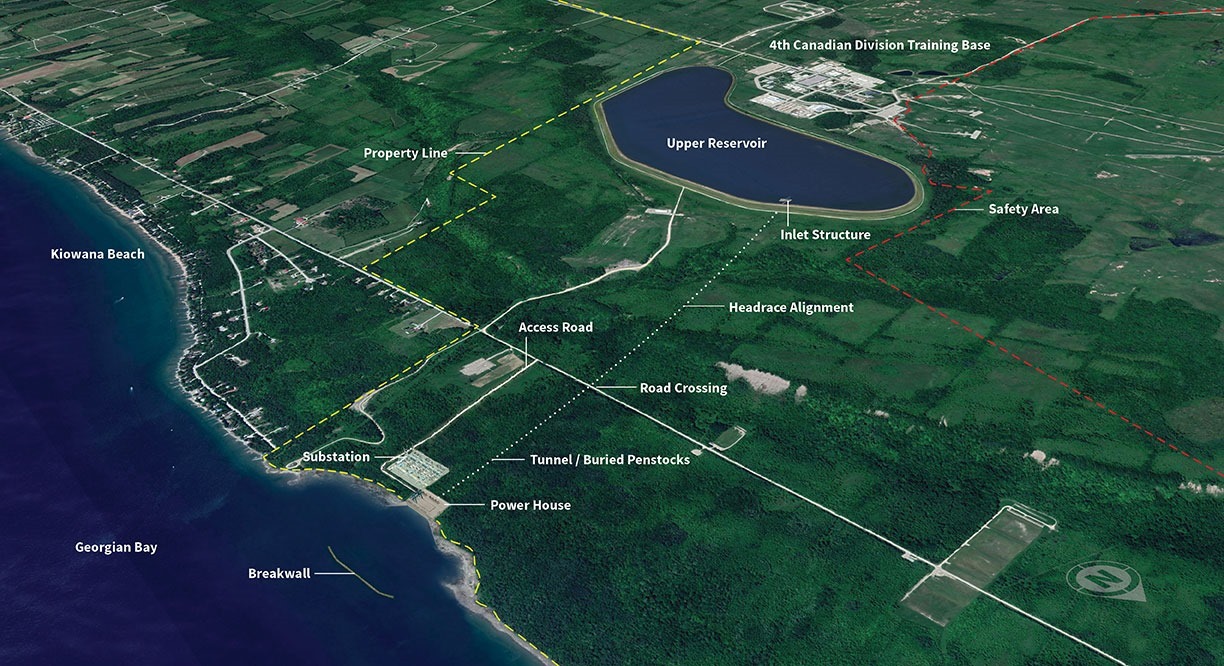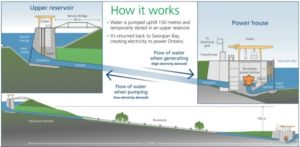No enthusiasm for TC Energy pumped storage project

Is project on federal land in the public’s best interest?
By Donna Baylis AWARE News Network
On January 16, 2020, about 150 people braved a snowy blustery night to attend the 2nd public information session hosted by TC Energy (TCE formerly TransCanada Pipelines) at the Meaford & St. Vincent Community Centre in Meaford.
The company called the meeting to talk about their idea for a pumped storage hydro generating facility proposed on property used by the Meaford Military Camp also known as Camp Meaford or “The Tank Range”. The property is owned by the federal government and used by the Department of National Defence (DND) for military training.
TransCanada approached the federal government with their idea in 2017. Under Canada’s Dominion Water Power Act (regulating energy generated from water resources on public land and vesting all such water power to be used for the benefit of the people) the DND is obliged to consider the idea.
The idea is to use the close connection between the Niagara Escarpment and the Georgian Bay to establish a pumped storage energy project. A water reservoir would be dug at the top of the escarpment. During off-peak hydro hours, water would be pumped into the reservoir. At peak hours when additional hydroelectricity is required by the province, and instead of buying hydro at a premium from other sources like the USA or Quebec, water would be released from the reservoir back into the Bay generating up to 1,000 megawatts of power over an 8 hour period, apparently enough energy to power the homes of around one million Ontarians. During off-peak hours the reservoir would be refilled taking an estimated 12 hours.
 The water reservoir is scaled at 350 acres (the equivalent of 175 Canadian football fields) and 20m (60’) deep.
The water reservoir is scaled at 350 acres (the equivalent of 175 Canadian football fields) and 20m (60’) deep.
The reservoir would be positioned at 150m / 500’ elevation about 2 kms from the shoreline.
The electricity would be generated using water and gravity and is expected to be around 70% efficient.
The pumped storage generation facility would be connected to the grid via Hydro One’s Essa Transmission Station, west of Barrie.
The mood in the room was openly hostile. When asked to raise their hands, the majority of people had attended the first public information session in December. The strategic proximity of the dates being near the holiday season and during heavy winter could not be missed. TC Energy were vowing to listen yet in fact were hesitantly but defiantly promoting. From the opening comments acknowledging use of the traditional territory of Saugeen Ojibway First Nation to the vow of mitigating harm to fish, people were suspicious and many had no qualms interrupting the speakers with their own concerns.
People asked how Meaford would benefit. A TCE representative declared the company is committed to carry their load and would not be a burden to the community. The company also touted $3.3 billion private sector investment and 800 construction jobs over 4 years of the project, local purchasing, and community investment by the corporation. Additionally, the company anticipates helping to lower Ontario’s electricity rates by $250 million per year while increasing reliability of the system and helping to reduce greenhouse gas emissions overall.
The introductory presentation was about 40 minutes, reviewing the slides in the handout and displayed on poster boards around the room. Several people asked that more questions be addressed in front of the audience, but the company opted to disperse deferring questions to the 15 or so staff members around the room. Of those staff members, only 4 seemed to have any significant knowledge of the project proposal.
Water generated electricity is regarded as renewable energy. This project walks a fine line because it requires water to be pumped up the escarpment. It could be argued that such a facility would be better than creating new or refurbishing old nuclear facilities with all the inherent radioactive risk and waste. It would also help balance the intermittent power generation of wind and solar energy. However, this project would require traditional power to run the pump for an estimated 12 hours after every use. Moving 350 acres by 20m of water is significant in a 12-hour period up such a steep elevation (150m) and would require a powerful pump, which would likely use more power than it generates. The company states that the technology is proven with 160K megawatts generated around the world.
First question: how does the project pay for itself?
The water would be stored during off-peak hours with excess power available. So instead of giving Ontario’s energy away to the U.S.A. or worse, essentially paying other utilities to take it, the power would be used to pump water from the Bay to the reservoir. Then when rates are high and energy is required, the water would be released from the reservoir to generate electricity. Thus, the facility is worth the difference in the peak and off-peak rates as well as any savings from paying premium rates to buy/sell energy from other sources.
Leading to the next question, should electric cars take on a critical mass, off-peak hours might disappear (i.e. electric cars would be plugged-in at night), how would the facility make money? Answer: to lock-in a profit, the company would be seeking rate regulation.
The project is technically feasible, but the jury is out on whether it is a good idea or not. Thus, TC Energy is to be commended for including Ontarians in this part of the process.
This summer after all consultations, TC Energy plans to decide whether to proceed.
On August 28, 2019, the Impact Assessment Act, the Canadian Energy Regulator Act, and the Canadian Navigable Waters Act came into force. The Impact Assessment Act created the new Impact Assessment Agency of Canada and repealed the Canadian Environmental Assessment Act, 2012.
Accordingly, should TCE decide to go ahead, an impact assessment would be undertaken by the Department of Defence to determine the affects on the Base and its training mandate. The process would be expected to take 1-2 years, ultimately deciding whether the project is in the public’s best interest. It should be noted that the DND would not be selling the land. The 3-5% of land area used would likely be setup as a licence or lease with cost recovery to the federal government only. The company would be seeking a 50-year economic life for the facility.
After that, having also addressed provincial assessment, design and commercial power processes (target 2023) construction would take around 4 years, with the facility targeted to begin operation in 2028.
It is too early in the process to know the complete environmental impacts on the Niagara Escarpment and Georgian Bay, although people suspect the worst. Therefore, it is worth keeping an eye on this project.
To find out more about this proposal, the third public information session is scheduled for Thursday, January 23, 2020 in the Meaford & St. Vincent Community Centre at 5:30pm. You can also check facebook “Save Georgian Bay Group” and www.tcenergy.com.









I SAY NO!!!!
The environmental impacts will be harrendius and will affect the entire bay over many years.
I am with Save Georgian Bay group. The site plan you are using is out of date and inaccurate. The end plan is to build this at the very southern boundary of the base. The reservoir would actually be built above peoples homes. Very concerning.
I am happy to provide updated information and offer our expertise in sharing information. Our team is made up of engineers, environmentalist, activists, consultants, business and home owners. We are happy to help and I thank you for taking this on. Cheers, Joanne
Thanks for heads-up, Joanne. Up-to-date graphic now posted.
The concept seems good. Overall, it seems that GHG emissions are reduced. It is a means for storing power when demand is low since most power generation cannot be turned on and off on a daily basis or it is uncontrollable when the wind is low and the sun doesn’t shine. However, we need to demand that an independent expert environmental and economic assessment be conducted and I don’t think this has been done yet.
Many of us connected to Thunder Beach Association in Tiny township are opposed to this project. It does not spear to be well researched nor suitable for the Meaford location.
I say no!! New design from TCE is again incomplete. This group has not surveyed the area to document the following:
– proximity of residents living in the impact zone, with a 375 acre reservoir directly above 148 residences
– proximity of shore wells, contamination of drinking water (proposal is still an open loop system)
– water turbidity and killing of millions of fish yearly
– shoreline erosion – millions of litres of water will be flushed through an outlet over an 8 hour period, no mention of water current studies
– clear cutting 500 acres of forests and displacing natural habitat
– If anyone wants more information please contact info@savegeorgianbay.com